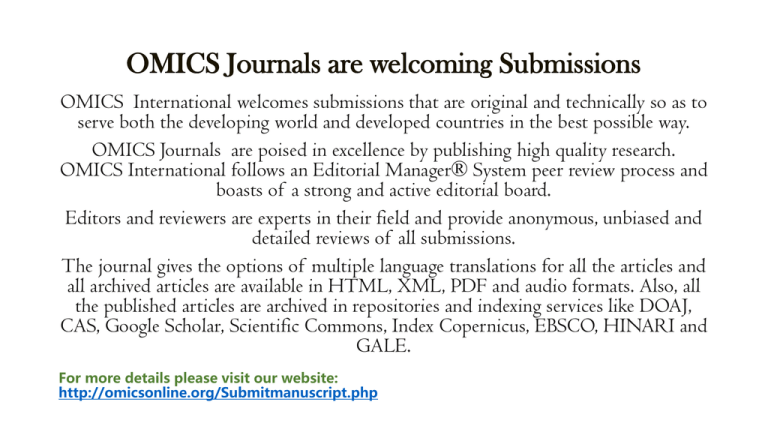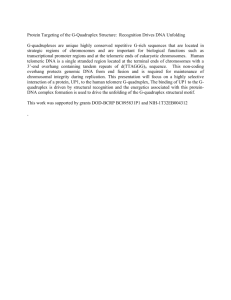PPT Slide Show
advertisement

OMICS Journals are welcoming Submissions OMICS International welcomes submissions that are original and technically so as to serve both the developing world and developed countries in the best possible way. OMICS Journals are poised in excellence by publishing high quality research. OMICS International follows an Editorial Manager® System peer review process and boasts of a strong and active editorial board. Editors and reviewers are experts in their field and provide anonymous, unbiased and detailed reviews of all submissions. The journal gives the options of multiple language translations for all the articles and all archived articles are available in HTML, XML, PDF and audio formats. Also, all the published articles are archived in repositories and indexing services like DOAJ, CAS, Google Scholar, Scientific Commons, Index Copernicus, EBSCO, HINARI and GALE. For more details please visit our website: http://omicsonline.org/Submitmanuscript.php Structure-based Drug Design : Nucleic Acids as anti-cancer drug target Dr. Prashansa Agrawal University of Arizona Structure-based Drug Design • Structure-based drug design process involves acquisition of information regarding the three-dimensional structure of biological ‘druggable’ target that plays a key role in the development of the disease, through methods such as x-ray crystallography, NMR spectroscopy or homology modeling. • Once the target has been identified, a potential drug candidate needs to be designed based on the binding affinity and selectivity for its target molecule. Approaches for Structure-based Drug Design • Design new molecules with high affinity for macromolecular receptor (target) whose 3D structure is known (receptor-based drug design). • In addition, the molecular interactions between the target and ligand can be utilized to support the binding of the current prototype into the active site of the receptor (pharmacophore-based drug design). Strategy for Structure-based Drug Design Identification of the target Screening a library of compounds Identification of a compound that binds to target and triggers specific biological actions Lead optimization Properties of the lead are tested with biological assays New molecules are designed and synthesized to obtain the desired properties Why Nucleic Acids are an important drug target? Nucleic acids play vital roles in genetic information storage, replication, transcription, and translation directing protein synthesis. Targeting nucleic acids can selectively interrupt gene expression for treating various diseases including cancers at the genetic level. Nucleic acids are the molecular targets of many chemotherapeutic anticancer drugs. More than 400 structures of drug-DNA or drug-RNA complexes have been deposited in the structural databases, e.g. PDB bank. Driving forces involved in Drug-DNA interactions Affinity is controlled by non-directional interactions: hydrophobic interactions Specificity is controlled by directional interactions: Van der waals interactions Covalent bonding Hydrogen bonding Electrostatic interactions Anthracycline antibiotics are used as potent cancer therapeutics Adriamycin (in which one hydrogen atom of methyl group at carbon position (9COCH3 moiety) of daunomycin is replaced by a hydroxyl group (9COCH2OH), 4'-epiadriamycin, (epimer of Adriamycin and differs at the 4'-position of the daunosamine sugar). H H H H H O H O H 1Oa H COCH3 1 12 10 11 9 OH 2 3 6 6a 7 8 H 4 5 H H O OCH3 O O H 1' 5' CH3 O H H 3' H H H 4' NH3+Cl- 2' OH H DAUNOMYCIN H H O H O H 1Oa H COCH2OH 1 12 10 11 9 OH 2 3 6 6a 7 8 H 4 5 H H O OCH3 O O H 5' 1' CH3 O H H 3' H H H 4' NH3+Cl- 2' H OH ADRIAMYCIN H H 2 3 H O 1 12 4 5 OCH3 O CH3 OH H O H 1Oa H COCH2OH 10 11 9 OH 6 6a 7 8 H H H O O H 5' 1' O H H 3' H H 4' NH3+Cl- 2' H 4’-EPIADRIAMYCIN Anthracycline antibiotics are good Intercalators The intercalation of drug to DNA causes modification in the tertiary structure of DNA leading to inhibition in transcription and cell proliferation. Anthraquinone derivatives were designed on the basis of anthracycline drugs that binds strongly to DNA and show anti-proliferative effects in vitro DAUNOMYCIN ANTHRAQUINONE DAUNOMYCIN Targeting DNA secondary structures ‘G-quadruplex’ • G-quadruplexes are commonly found in telomere region and the oncogene promoter region which are highly G-rich and dynamic in nature. • They are formed by stacking of G-tetrads. • Each G-tetrad has four guanines arranged in square planar manner, stabilized by hoogesten hydrogen bond. G-quadruplex G-tetrad G-Quadruplex-interacting Ligand Design Common DNA intercalators Berberin Cryptolepine Proflavine Ethidium bromide • DNA intercalators are toxic • Characterized by large, flat aromatic core, possibly protonated in center • Need to design ligands selective for G-quadruplex DNA Chan, A., et al. J. Med. Chem. 2005, 48, 7315-7321. 12 Types of G-Quadruplex-interacting ligands Polycycles Macrocycles 13 Acridine Derivative Synthesized in 2001 based on parent acridine intercalator 45:1 selectivity for G-quadruplex DNA versus duplex DNA Phase I/II clinical trial Read, M. et al. Proc. Natl. Acad. Sci. U.S.A. 2001, 98, 4844-4849. 14 G-quadruplex-interactive molecule BRACO-19 inhibits tumor growth, consistent with telomere targeting and interference with telomerase function Read, M. et al. Proc. Natl. Acad. Sci. U.S.A. 2001, 98, 4844-4849. 15 Quindolines lower c-myc expression in hepatocellular carcinoma cell line Hep G2 and Burkitt’s lymphoma cell line Ramos. HN N H N N Cmyc G-quadruplex Ambrus et al. Biochemistry, 2005 , 44, 2048 Quindoline Ou et al. J. Med Chem. 2007, 50, 1465 Triazoles π stacking with guanine bases Moorhouse, A.D., et al. J. Am. Chem. Soc. 2006, 128, 15972-15973. 17 Heterocycle-Peptides greater than 50:1 selectivity for G-quadruplex DNA versus duplex DNA Schouten, J.A., et al. J. Am. Chem. Soc. 2003, 125, 5594-5595. Green, J.J., et al. J. Am. Chem. Soc. 2006, 128, 9809-9812. 18 Metal Complexes Ni(II) forces planarity, resulting in π stacking Piperidine interaction with phosphate backbone Reed, J.E., et al. J. Am. Chem. Soc. 2006, 128, 5992-5993. 19 Cyclic Oxazoles Telomestatin EC50 5 nM First isolated in 2001 from Streptomyces anulatus Total synthesis finished in 2006, 21 steps, <1% overall yield First natural product shown to bind selectively to G-quadruplex DNA Shin-ya, K., et al. J. Am. Chem. Soc. 2001, 123, 1262-1263. Doi, T., et al. Org. Lett. 2006, 8, 4165-4167. 20 Fluoroquinolone Derivative Quarfloxin Quarfloxin shows antineoplastic activity. Quarfloxin disrupts the interaction between the nucleolin protein and G-quadruplex DNA in the ribosomal DNA (rDNA) template, a critical interaction for rRNA biogenesis that is overexpressed in cancer cells. This may result in inhibition of ribosome synthesis and tumor cell apoptosis. Phase I/II clinical trial. Balasubramanian, S. Nat Rev Drug Discov. 2011, 10, 261–275. Future Directions on Structure-based Drug Design Learning from the past experience. Need deeper understanding of identifying suitable hits/ligands to prevent them from failing during clinical trials. Toxicity and safety issues needs to be addressed in order to reduce the attrition rate. Developing efficient methods to gain understanding at the atomic level of the target-ligand interaction and use that information in drug design. 22 Pharmacovigilance Related Journals Journal of Clinical Trials Advances in Pharmacoepidemiology & Drug Safety Journal of Drug Metabolism & Toxicology Pharmacovigilance Related Conferences For further details regarding the conference please visit http://www.conferenceseries.com/pharmaceutical-sciencesmeetings/ OMICS Group Open Access Membership Open Access Membership with OMICS international enables academicians and research institutions, funders and corporations to actively encourage open access in scholarly communication and the dissemination of research published by their authors. For more details and benefits, click on the link below: http://omicsonline.org/membership.php




